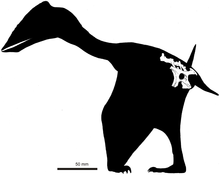Vectidraco
| Vectidraco Temporal range: Lower Cretaceous
| |
|---|---|

| |
| Holotype NHMUK PV R36621 | |
| Scientific classification | |
| Domain: | Eukaryota |
| Kingdom: | Animalia |
| Phylum: | Chordata |
| Order: | †Pterosauria |
| Suborder: | †Pterodactyloidea |
| Family: | †Tapejaridae |
| Subfamily: | †Tapejarinae |
| Genus: | †Vectidraco Naish et al., 2013 |
| Type species | |
| †Vectidraco daisymorrisae Naish et al., 2013
| |
Vectidraco (meaning "dragon from the Isle of Wight"), is a genus of azhdarchoid pterosaur from the Lower Cretaceous of England.
In November 2008 the four years old Daisy Morris of Whitwell, Isle of Wight, an avid natural history collector, discovered some small bones at the cliff face of Atherfield Point at the southwest coast of Wight. Her parents carefully removed any fossils they could find from the rock and donated the specimen to the Natural History Museum.[1] Daisy's discovery was authenticated by palaeontologist Martin Simpson, from the University of Southampton.[2][3]

A scientific paper was published in 2013 about the find in the electronic journal PLoS ONE, titled A New Small-Bodied Azhdarchoid Pterosaur from the Lower Cretaceous of England and Its Implications for Pterosaur Anatomy, Diversity and Phylogeny. In it Darren Naish, Martin Simpson, and Gareth Dyke described and named the type species Vectidraco daisymorrisae. The generic name is derived from the Latin Vectis, the Roman name of the island now known as the Isle of Wight, and dracō, meaning "dragon". The specific name honours the discoverer Daisy Morris.[3][1] A children's book has also been written by Simpson about Daisy Morris's discovery, called Daisy and the Isle of Wight Dragon.[4]
The only known specimen, holotype NHMUK PV R36621, was uncovered in the Chale Clay Member of the Atherfield Clay Formation of the Lower Greensand Group, a clay layer of the Deshayesites forbesi zone, Deshayesites fittoni subzone, dating from the early Aptian, with an age of 124 million years. It consists of the left side of a pelvis, the right ischium, the rear dorsal vertebra and the first three sacral vertebrae, of a subadult or adult individual.[3]
Vectidraco is a relatively small pterosaur. The pelvis is four centimetres long as preserved. Vectidraco's wingspan was estimated at seventy-five centimetres, its total body length at thirty-five centimetres. In view of its affinities, the describing authors assumed it was a toothless form, featuring a crest on its snout.[3]
Several unique derived traits, autapomorphies, were established. The hip joint is bordered at its top rear corner by a triangular depression. This depression is overhung by a ridge running downwards to the rear. The front blade of the ilium features an undivided roughly oval depression at its front inner side, below a convex surface. Furthermore a unique combination of traits is present in that the elongated rear blade of the ilium is T-shaped, terminating in a wide expansion also projecting upwards, that is longer than the shaft of the rear blade itself.[3]

Damage to the ilium shows the presence of camellate bone, internal air chambers. Also all the preserved vertebrae are pneumatised.[3]
Vectidraco was assigned to the Azhdarchoidea, in a basal position. If correct, this would make it one of the smallest azhdarchoids known.[3]
References
- ^ a b "Isle of Wight girl Daisy Morris has flying prehistoric beast named after her". BBC News. 20 March 2013. Retrieved 22 March 2013.
- ^ http://metro.co.uk/2013/03/20/schoolgirl-daisy-morris-discovers-flying-dinosaur-fossil-on-isle-of-wight-beach-3550644/
- ^ a b c d e f g Attention: This template ({{cite doi}}) is deprecated. To cite the publication identified by doi:10.1371/journal.pone.0058451, please use {{cite journal}} (if it was published in a bona fide academic journal, otherwise {{cite report}} with
|doi=10.1371/journal.pone.0058451instead. - ^ http://www.huffingtonpost.co.uk/2013/03/21/dinosaur-discovery-girl-daisy-morris_n_2923191.html
